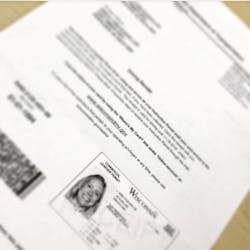Testing for the commercial driver learner permit
I haven’t studied for a learner’s permit in 20 years.
Back when I first went to school to get my driver's license, I remember furiously highlighting the paper manuals from the driving school instructor, making sure to note the questions “you’ll certainly see on the written test.”
Nowadays though, they’ve got smartphone apps and downloadable PDFs you can use as study aids. Having everything accessible online and at your fingertips can be both a blessing and a curse.
And thank goodness, since there’s a lot more information to know. The trucking industry is federally regulated, but drivers test for and receive a state-issued commercial driver's license. But, every state has similar exams to test for the learner permit. To obtain a learner permit, especially for the purposes of the WCTC class and for driving a Class 8 tractor-trailer in the state of Wisconsin, I needed to take three tests: General Knowledge, Air Brakes and Combination.
Note: There are some variances from state-to-state when it comes to these tests. All require a general knowledge test, and a combination test. But, some may allow an air brakes restriction on a commercial driver's license.
General Knowledge (50 questions).This exam covers the gamut when it comes to running a commercial vehicle, including safety and communication, road signs, hours of service, road and user hazards, and more.
Some sample questions include:
What is the gross vehicle weight (GVW)?
- The total weight that includes the vehicle, towed vehicles, and the load
- The total weight of a single vehicle and its load (correct answer)
- A vehicle's maximum weight rating, specified by its manufacturer
- All of the above
How far ahead should drivers look while driving on a highway?
- 10 to 12 seconds
- 5 to 10 seconds
- 12 to 15 seconds (correct answer)
- 7 to 12 seconds
What action should you take before driving while drowsy?
- Pull off the road and get some sleep. (correct answer)
- Open your vehicle windows for some fresh air.
- Drink energy drinks.
- Drink a cup of coffee.
Air Brakes (25 questions). This talks about the three separate (but really, connected) braking systems on a combination vehicle - the emergency brakes, the parking brakes and the service brakes. All are managed and maintained through the air braking system of the truck. If you've ever sat in the cab, you're likely familiar with the yellow (tractor) and red (trailer) buttons on the dash. In order to move, they need to be pushed in.
Combination (20 questions). If you plan to drive more than a straight truck, or bobtail (aka, just the tractor), you're going to need to take the combination test. Essentially, this test covers aspects of coupling and uncoupling the tractor and trailer.
You need at least an 80 percent to pass for each exam, and you can take each test up to five times, limited to once per day.
In addition to these tests, you can add separate endorsements for the following: Hazmat, Doubles and Triples, and Tankers. While I didn't test for these for my learner permit, I'm able to add them at anytime after receiving my CDL.
Also, speaking of restrictions, you can have a restriction placed on your CDL to not drive manual transmissions. (e.g. only automated manuals or full automatics.)
But really, if I'm going to learn how to drive a truck, I should learn how to do it right. And, now that I've got that learner's permit testing out of the way, I'm ready to hit the road.
…
In the Driver’s Seat is a blog series from Fleet Maintenance editor-in-chief Erica Schueller. The series covers the process of attending a formalized technical training professional truck driving program in order to obtain a Class commercial vehicle driver’s license.
About the Author
Erica Schueller
Media Relations Manager | Navistar
Erica Schueller is the Media Relations Manager for Navistar.
Before joining Navistar, Schueller served as Editorial Director of the Endeavor Commercial Vehicle Group. The commercial vehicle group includes the following brands: American Trucker, Bulk Transporter, Fleet Maintenance, FleetOwner, Refrigerated Transporter, and Trailer/Body Builders brands.
An award-winning journalist, Schueller has reported and written about the vehicle maintenance and repair industry her entire career. She has received accolades for her reporting and editing in the commercial and automotive vehicle fields by the Truck Writers of North America (TWNA), the International Automotive Media Competition (IAMC), the Folio: Eddie & Ozzie Awards and the American Society of Business Publication Editors (ASBPE) Azbee Awards.
Schueller has received recognition among her publishing industry peers as a recipient of the 2014 Folio Top Women in Media Rising Stars award, acknowledging her accomplishments of digital content management and assistance with improving the print and digital products in the Vehicle Repair Group. She was also named one Women in Trucking’s 2018 Top Women in Transportation to Watch.
She is an active member of a number of industry groups, including the American Trucking Associations' (ATA) Technology & Maintenance Council (TMC), the Auto Care Association's Young Auto Care Networking Group, GenNext, and Women in Trucking.
In December 2018, Schueller graduated at the top of her class from the Waukesha County Technical College's 10-week professional truck driving program, earning her Class A commercial driver's license (CDL).
She has worked in the vehicle repair and maintenance industry since 2008.

